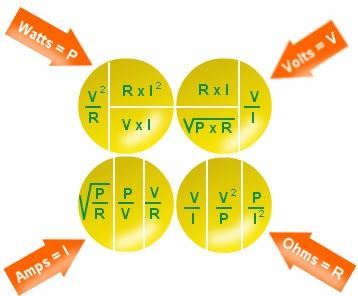Electricity is the flow of charge in a conductor from anode to cathode. Electricity has varied applications. It acts as a tool to provide power to electrical devices. We can say the flow of charge builds up the current, which we call Electricity. To understand how the Electricity is generated, we need to understand the various basic parameters related to it like the voltage, current, resistance, conductivity and the relation among them.

Some of the commonly used Electricity formulae are listed below.
| Quantity | Formulas | Unit |
| Current I | I = Q / t
Q = Charge t = time taken |
Amperes (A) |
| Voltage V | V = E / Q
or V = W / Q E = Energy, W = Work done |
Volts (V) |
| Resistance R | R = ρl / A
ρ = Resistivity, l = length, A = Area or, R = V / I |
Ohm (Ω) |
| Power P | P = VI | Watts (W) |
| Conductivity σ | sigma = 1 / ρ | Siemens per meter (S/m) |
Electricity Formulas are applied in calculating the unknown electrical parameters from the known in electric circuits.
Solved Examples
Example 1
An electric heater has a potential difference of 220 V and resistance is 70 Ω. Determine the magnitude of the current flowing through it.
Solution:
Given:
Resistance R = 70 Ω
Voltage V = 220 V
The current formula is given by
I = V / R
= 220 / 70
I = 3.1428 A
Example 2
An electrical lamp lights for 4 hours and draws a current of 0.5 A. Calculate the amount of charge flowing through the lamp.
Solution:
Current I = 0.5 A
Time taken t = 4 hours
t= 4 × 3600 = 14400 s,
Charge Q = I × t
= 0.5 ×14400
Q= 7200 C
Very nicely you are helpful for me coz i understand everything that i know
yes even me
Helpfull
I’m a student of class 10 and I was full of doubt about the formulas and I am so happy To understand it by you ,thank you byjus
Thanks for formulas
Very nicely and helpful
very helpful formulae
Very nice sir absolutely byjus is a great website or app
Thank you very much byju’s
It helps me a lot
You are very helpful for me
Excellent understanding, best quality questions and there solutions . External support of brilliant understanding.
It works in board exam 👍
Thanks I like it
THANK YOU
Relly this formula and equation help me to understand the formulas 😃😄😄😀🙂🙂
Thanks you very helpful.
Good and easy way। Of learning
Thank u sooo much for explaining in such a beautiful way.
thanks. it is helpful
Your electricity formula diagram was very helpful in that it brought back many of the formulas that I have forgotten in my aging years. It is nice to have an easy reference to go to. However, I ask that you review your formula in the upper right hand quadrant where you have V = V/I. Unless I have mistaken the intent, I believe that this should be V = W/I.
Very nice help thank u for supporting children
It really works in board exam 👍👍👍👍👍
Very nice I was finding the formula in textbook and now I got all the formula on one website
Really helpful specially for the last time formula go through with the units
Byjus has always helped me with my studies. Thank u byjus.
Thank you
Very helpful
Very useful/helpful for study
This is very easy way to learn and understand this formulas .
thanks a lot byjus, tomorrow i am having an exam, so I was revising the formulas,and that time i saw that byjus had all formulas in electricity, It helped me a lot ,Thank you.
Very nice formula for class 10 and very useful
Thanks you have helped me a lot
Thank you BYJUS, your notes are absolutely great.
It literally helped
Thank you sir/mam for the formulas and examples, it helped me a lot.